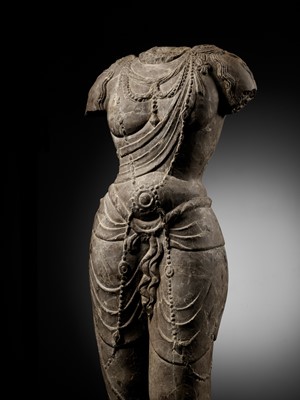11th Oct, 2023 11:00
THREE-DAY AUCTION - Fine Chinese Art / 中國藝術集珍 / Buddhism & Hinduism
171
† A LIMESTONE TORSO OF A BODHISATTVA, TANG DYNASTY
唐代石灰石菩薩殘軀
Sold for €42,900
including Buyer's Premium
China, early 8th century. The slender, elegant figure well carved standing in a subtle tribhanga pose, wearing a clinging diaphanous skirt falling in graceful folds, with scarves tied diagonally around the torso and draped from the shoulders, richly adorned with elaborate jewelry including beaded and foliate necklaces as well as pendent ornaments of floral design. The gray limestone with hues of maroon and a superb, naturally grown patina overall.
Provenance: From the personal collection of Ed Hardy, who is an American artist known for his strong influence on the development of modern tattoo styles, and his eponymous apparel and accessories brand. He became recognized for being the main driver in incorporating ancient Asian tattoo aesthetics and techniques into Western styles of work, taking tattoos from a fringe culture into the mainstream.
Condition: Good condition, commensurate with age. Extensive wear, losses, nicks, scratches, a minor structural crack with an associated old fill (only visible under strong blue light), signs of weathering and erosion, encrustations. Overall displaying exceptionally well.
Weight: 39.9 kg (incl. stand)
Dimensions: Height 58.5 cm (excl. stand) and 67.4 cm (incl. stand)
Please click here to read the full description
With a modern metal stand. (2)
Expert’s note: The 5th-century Gupta influence on Tang Buddhist sculpture is manifest in the sensuously rounded body of the present lot, together with the diaphanous robes and jewelry. Two related Tang Dynasty bodhisattvas, standing in contrapposto and currently residing in the Zhengzhou Museum, published in Annette Juliano's Treasures of Ancient China in 1981 (see image section), were unearthed at the site of the Dahai Monastery in Xingyang County, Henan Province. The folds to the robes, the simplified jewelry over the outlined pectorals, and the slightly forward abdominal bulge are all similar to the current lot, which may originate from the same region.
Literature comparison:
Stylistically, the present figure relates most closely to some of the Tianlongshan figures. Compare a related sandstone figure from Tianlongshan, Shanxi Province, 101.6 cm high, dated approx. 700-750, in the Asian Art Museum of San Francisco, object number B60S6+. The present figure is also related to some of the larger figures from Longmen, such as the standing bodhisattva in a similar pose, with U-shaped drapery folds and roll of material at the waist, illustrated in Longmen Liusan Diaoxiang Ji (The Lost Statues of the Longmen Caves), Shanghai, 1993, p. 71, no. 78. Compare a similar stone figure of a bodhisattva illustrated by O. Siren, Kinas Kunst Under Tre Artusenden, vol. 2, Stockholm, 1943, fig. 73A. For a related figure in white marble with more elaborate realization of the drapery and with one foot placed slightly forward, see the figure from Longyenshan, Hebei, illustrated by W. Willetts, Foundations of Chinese Art, London, 1965, p. 222, fig. 139.
Auction result comparison:
Type: Closely related
Auction: Christie’s New York, 22 March 1999, lot 162
Price: USD 134,500 or approx. EUR 218,000 converted and adjusted for inflation at the time of writing
Description: A rare well-carved gray stone torso of a bodhisattva, Tang dynasty, early 8th century
Expert remark: Compare the closely related pose, drapery, and folds. Note the related size (63.5 cm).
点此阅读中文翻译 (Chinese Translation)
唐代石灰石菩薩殘軀
優雅身姿,三曲式,外衣輕薄而貼身,飾有精美的珠寶,如串珠和葉狀項鍊以及花卉紋的吊飾。順著身體結構起伏,雙腿輪廓隱約可見,褶皺線條流暢。灰色石灰石,自然包漿光滑。
來源:美國藝術家 Ed Hardy 私人收藏,Ed Hardy 因其對現代紋身風格發展的強大影響而聞名,以及他的同名服裝和配飾品牌。他可以説是將古代亞洲紋身美學和技術融入西方工作風格的主要推動者,將紋身從邊緣文化帶入主流。
品相:狀態良好,大面積磨損、缺損、刻痕、劃痕、與舊填充物相關的輕微結構裂縫(僅在強藍光下可見)、風化和侵蝕的跡象、結殼。
重量:39.9 公斤 (含底座)
尺寸:高 58.5 厘米 (不含底座) 及67.4 厘米 (含底座)
現代金屬支架 (2)
專家注釋:五世紀笈多王朝對唐代佛教雕塑的影響體現在本拍品圓潤的身體以及透明的長袍和珠寶上。河南省滎陽縣大海寺遺址出土了兩尊相近的唐代菩薩立像,現藏於鄭州博物館,見Annette Juliano 1981年出版的《Treasures of Ancient China》(見圖片部分)。 袈裟的褶皺、胸前華麗的飾物、腹部略微前凸的部分,均與本拍品相似,可能出自同一地區。
文獻比較:
從風格上看,本尊與天龍山的一些人像最為接近。比較一件相近的約700-750年山西天龍山石窟砂岩像,高101.6 釐米,收藏於舊金山亞洲藝術博物館,館藏編號B60S6+。另一件龍門石窟相近姿勢的菩薩像,見《龍門流散雕像集》,上海,1993年,頁71,編號78。比較一件相似的菩薩石像,O. Siren,《Kinas Kunst Under Tre Artusenden》,卷2,斯德哥爾摩,1943年,圖73A。一件相近白色大理石佛像,帷幔更加精緻,一隻腳稍微向前放置,見《figure from Longyenshan》,河北,見W. Willetts,《Foundations of Chinese Art》,倫敦,1965,頁222,圖139。
拍賣結果比較:
形制:非常相近
拍賣:紐約佳士得,1999年3月22日,lot 162
價格:USD 134,500(相當於今日EUR 218,000)
描述:八世紀初期唐代菩薩殘軀
專家評論:比較非常相近的姿勢、罩衫和皺褶。請注意相近 尺寸 (63.5 釐米)。
China, early 8th century. The slender, elegant figure well carved standing in a subtle tribhanga pose, wearing a clinging diaphanous skirt falling in graceful folds, with scarves tied diagonally around the torso and draped from the shoulders, richly adorned with elaborate jewelry including beaded and foliate necklaces as well as pendent ornaments of floral design. The gray limestone with hues of maroon and a superb, naturally grown patina overall.
Provenance: From the personal collection of Ed Hardy, who is an American artist known for his strong influence on the development of modern tattoo styles, and his eponymous apparel and accessories brand. He became recognized for being the main driver in incorporating ancient Asian tattoo aesthetics and techniques into Western styles of work, taking tattoos from a fringe culture into the mainstream.
Condition: Good condition, commensurate with age. Extensive wear, losses, nicks, scratches, a minor structural crack with an associated old fill (only visible under strong blue light), signs of weathering and erosion, encrustations. Overall displaying exceptionally well.
Weight: 39.9 kg (incl. stand)
Dimensions: Height 58.5 cm (excl. stand) and 67.4 cm (incl. stand)
Please click here to read the full description
With a modern metal stand. (2)
Expert’s note: The 5th-century Gupta influence on Tang Buddhist sculpture is manifest in the sensuously rounded body of the present lot, together with the diaphanous robes and jewelry. Two related Tang Dynasty bodhisattvas, standing in contrapposto and currently residing in the Zhengzhou Museum, published in Annette Juliano's Treasures of Ancient China in 1981 (see image section), were unearthed at the site of the Dahai Monastery in Xingyang County, Henan Province. The folds to the robes, the simplified jewelry over the outlined pectorals, and the slightly forward abdominal bulge are all similar to the current lot, which may originate from the same region.
Literature comparison:
Stylistically, the present figure relates most closely to some of the Tianlongshan figures. Compare a related sandstone figure from Tianlongshan, Shanxi Province, 101.6 cm high, dated approx. 700-750, in the Asian Art Museum of San Francisco, object number B60S6+. The present figure is also related to some of the larger figures from Longmen, such as the standing bodhisattva in a similar pose, with U-shaped drapery folds and roll of material at the waist, illustrated in Longmen Liusan Diaoxiang Ji (The Lost Statues of the Longmen Caves), Shanghai, 1993, p. 71, no. 78. Compare a similar stone figure of a bodhisattva illustrated by O. Siren, Kinas Kunst Under Tre Artusenden, vol. 2, Stockholm, 1943, fig. 73A. For a related figure in white marble with more elaborate realization of the drapery and with one foot placed slightly forward, see the figure from Longyenshan, Hebei, illustrated by W. Willetts, Foundations of Chinese Art, London, 1965, p. 222, fig. 139.
Auction result comparison:
Type: Closely related
Auction: Christie’s New York, 22 March 1999, lot 162
Price: USD 134,500 or approx. EUR 218,000 converted and adjusted for inflation at the time of writing
Description: A rare well-carved gray stone torso of a bodhisattva, Tang dynasty, early 8th century
Expert remark: Compare the closely related pose, drapery, and folds. Note the related size (63.5 cm).
点此阅读中文翻译 (Chinese Translation)
唐代石灰石菩薩殘軀
優雅身姿,三曲式,外衣輕薄而貼身,飾有精美的珠寶,如串珠和葉狀項鍊以及花卉紋的吊飾。順著身體結構起伏,雙腿輪廓隱約可見,褶皺線條流暢。灰色石灰石,自然包漿光滑。
來源:美國藝術家 Ed Hardy 私人收藏,Ed Hardy 因其對現代紋身風格發展的強大影響而聞名,以及他的同名服裝和配飾品牌。他可以説是將古代亞洲紋身美學和技術融入西方工作風格的主要推動者,將紋身從邊緣文化帶入主流。
品相:狀態良好,大面積磨損、缺損、刻痕、劃痕、與舊填充物相關的輕微結構裂縫(僅在強藍光下可見)、風化和侵蝕的跡象、結殼。
重量:39.9 公斤 (含底座)
尺寸:高 58.5 厘米 (不含底座) 及67.4 厘米 (含底座)
現代金屬支架 (2)
專家注釋:五世紀笈多王朝對唐代佛教雕塑的影響體現在本拍品圓潤的身體以及透明的長袍和珠寶上。河南省滎陽縣大海寺遺址出土了兩尊相近的唐代菩薩立像,現藏於鄭州博物館,見Annette Juliano 1981年出版的《Treasures of Ancient China》(見圖片部分)。 袈裟的褶皺、胸前華麗的飾物、腹部略微前凸的部分,均與本拍品相似,可能出自同一地區。
文獻比較:
從風格上看,本尊與天龍山的一些人像最為接近。比較一件相近的約700-750年山西天龍山石窟砂岩像,高101.6 釐米,收藏於舊金山亞洲藝術博物館,館藏編號B60S6+。另一件龍門石窟相近姿勢的菩薩像,見《龍門流散雕像集》,上海,1993年,頁71,編號78。比較一件相似的菩薩石像,O. Siren,《Kinas Kunst Under Tre Artusenden》,卷2,斯德哥爾摩,1943年,圖73A。一件相近白色大理石佛像,帷幔更加精緻,一隻腳稍微向前放置,見《figure from Longyenshan》,河北,見W. Willetts,《Foundations of Chinese Art》,倫敦,1965,頁222,圖139。
拍賣結果比較:
形制:非常相近
拍賣:紐約佳士得,1999年3月22日,lot 162
價格:USD 134,500(相當於今日EUR 218,000)
描述:八世紀初期唐代菩薩殘軀
專家評論:比較非常相近的姿勢、罩衫和皺褶。請注意相近 尺寸 (63.5 釐米)。
Zacke Live Online Bidding
Our online bidding platform makes it easier than ever to bid in our auctions! When you bid through our website, you can take advantage of our premium buyer's terms without incurring any additional online bidding surcharges.
To bid live online, you'll need to create an online account. Once your account is created and your identity is verified, you can register to bid in an auction up to 12 hours before the auction begins.
Intended Spend and Bid Limits
When you register to bid in an online auction, you will need to share your intended maximum spending budget for the auction. We will then review your intended spend and set a bid limit for you. Once you have pre-registered for a live online auction, you can see your intended spend and bid limit by going to 'Account Settings' and clicking on 'Live Bidding Registrations'.
Your bid limit will be the maximum amount you can bid during the auction. Your bid limit is for the hammer price and is not affected by the buyer’s premium and VAT. For example, if you have a bid limit of €1,000 and place two winning bids for €300 and €200, then you will only be able to bid €500 for the rest of the auction. If you try to place a bid that is higher than €500, you will not be able to do so.
Online Absentee and Telephone Bids
You can now leave absentee and telephone bids on our website!
Absentee Bidding
Once you've created an account and your identity is verified, you can leave your absentee bid directly on the lot page. We will contact you when your bids have been confirmed.
Telephone Bidding
Once you've created an account and your identity is verified, you can leave telephone bids online. We will contact you when your bids have been confirmed.
Classic Absentee and Telephone Bidding Form
You can still submit absentee and telephone bids by email or fax if you prefer. Simply fill out the Absentee Bidding/Telephone bidding form and return it to us by email at office@zacke.at or by fax at +43 (1) 532 04 52 20. You can download the PDF from our Upcoming Auctions page.
How-To Guides
How to Create Your Personal Zacke Account
How to Register to Bid on Zacke Live
How to Leave Absentee Bids Online
How to Leave Telephone Bids Online
中文版本的操作指南
创建新账号
注册Zacke Live在线直播竞拍(免平台费)
缺席投标和电话投标
Third-Party Bidding
We partner with best-in-class third-party partners to make it easy for you to bid online in the channel of your choice. Please note that if you bid with one of our third-party online partners, then there will be a live bidding surcharge on top of your final purchase price. You can find all of our fees here. Here's a full list of our third-party partners:
- 51 Bid Live
- EpaiLive
- ArtFoxLive
- Invaluable
- LiveAuctioneers
- the-saleroom
- lot-tissimo
- Drouot
Please note that we place different auctions on different platforms. For example, in general, we only place Chinese art auctions on 51 Bid Live.
Bidding in Person
You must register to bid in person and will be assigned a paddle at the auction. Please contact us at office@zacke.at or +43 (1) 532 04 52 for the latest local health and safety guidelines.













